Webmaster Note: This History of Past and Continuing Exhibits and Functional Re-Creations was basically compiled by Doug Beaton, a long-time volunteer and the person primarily responsible for the build up and cataloging of virtually all of the Diefenbunker’s Collection of Archives and Artifacts as well as the acquisition and display of its current library of over 6000 volumes and pamphlets. I have added a few that I remember.
Past Exhibits
Fallout Exhibit – In the early operating years of the museum, volunteers worked with local high schools and teachers to construct exhibits that were part of the student’s curriculum projects under the museum’s school program. One such exhibit explained and illustrated various aspects of a theoretical nuclear attack on the Ottawa area. Panels highlighted blast damage and fallout patterns while dioramas helped to visualize the design of fallout shelters.
The Strategic Threat – Curated and built by several volunteers under the guidance of Dave Peters, this one room exhibit detailed the actual threat posed by the Soviet Union during the Cold War by mounting charts of their weapons capability and others exposing the ability of North America to defend itself. One large diorama used a sound and light effect to illustrate the possible damage to a small town by blast effects.
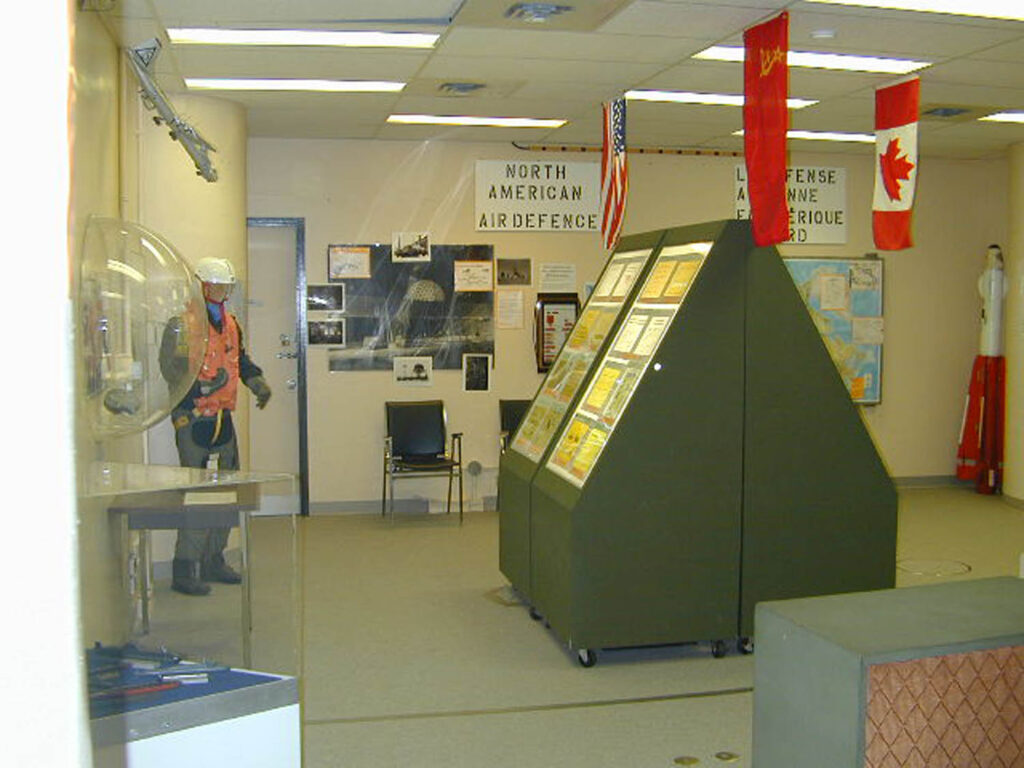
The following is excerpted from the original description of this exhibit:
“The general theme of the exhibit is the threat to North America posed by the Soviet Union’s nuclear arsenal and the United State’s and Canadian response to that threat. The exhibit tries to graphically portray information about numbers and types of nuclear weapons and their means of “delivery”(bombers, missiles and submarines). As well, the Canadian aspects of the North American air defence systems including the DEW and Pine Tree Line radar system are displayed along with very accurate models of the three Canadian interceptor aircraft deployed during the Cold War (the CF 100 “Canuck”, the CF 101 “Voodoo” and the CF 18).
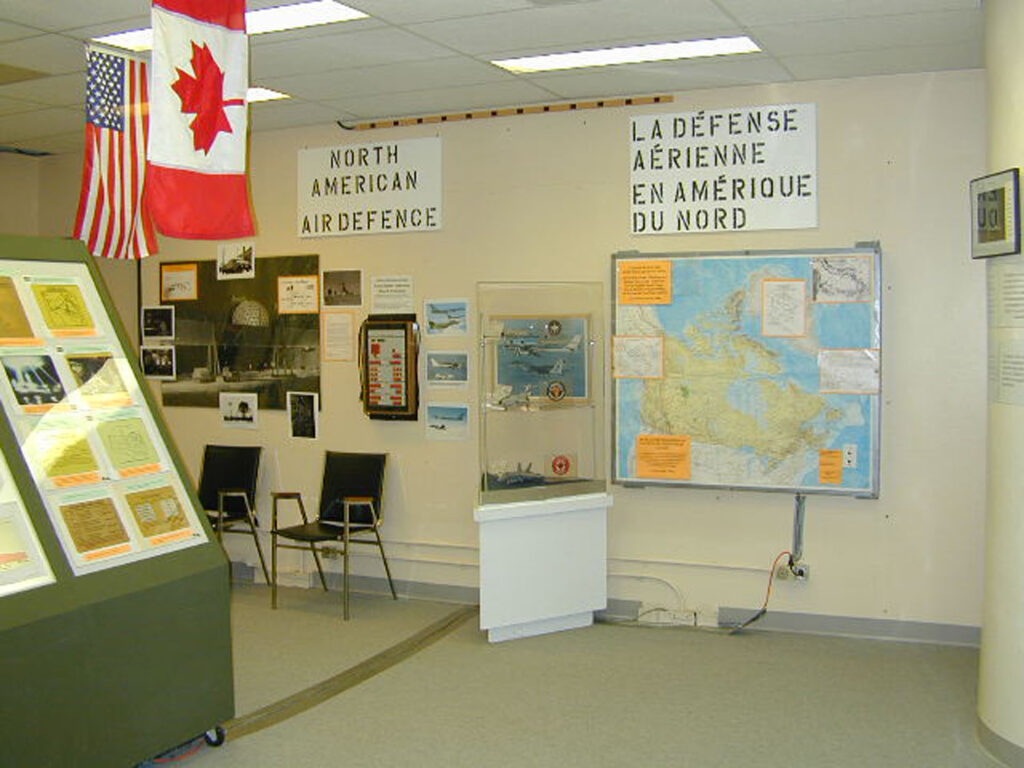
Four vertical backlighted “obelisks” are used to display over forty overhead projection slides (OHPs) actually used to brief military and civil defence officials during the 1970 to 1990 period. As well there is a piston-head from the first major aircraft crash involving a nuclear weapon. It happened in BC in 1950. Such incidents are referred to (by those in the trade) as “Broken Arrow” situations. To quote from a movie having a Broken Arrow as the plot, “ I don’t know which is worse – the fact that such a event can occur, or that it happens so often that they need a name for it!”
One particularly interesting element of the exhibit is the push button activated 90 second, “sound and light”, voice-narrated, active diorama illustrating a Soviet attack on North American cities and the Canadian and United States defensive and offensive response. Hugh Pett was our IT FX expert in putting this complicated diorama together. In keeping with our efforts to be as bilingual as possible there are two buttons to push, one for English and one for French. Hold onto yourself when the bomb explodes!”
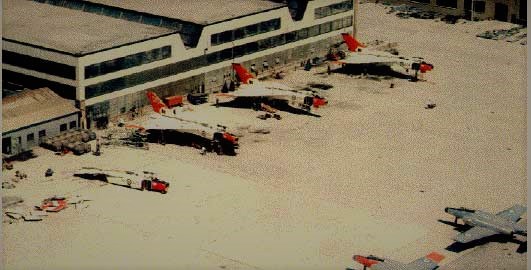
AVRO Arrow Exhibit and Destruction Model – The museum hosted a traveling exhibit on the Avro Arrow and sponsored a lecture by Peter Zuuring who is the author of several books on the Arrow. A piece of an Arrow Orenda engine was donated to the museum. In addition, the museum brought in Jan Zurakowski, the last surviving pilot of the Arrow fleet. The destruction diorama was crafted by a volunteer and master model maker. It reproduces the famous 1959 scene of the rollout and destruction of a number of the AVRO Arrows.
Treasures from the Collections – Curated by volunteer Collections Manager Doug Beaton, this one room multi-year exhibit highlighted dozens of the rare artefacts in the Diefenbunker, CCWM’s collection and archive.
The Continuity of Government – Created by Dave Peters and others it was located in a large corner room on the 400 level. Text panels, photographs, artefacts, and overhead projection slides explained in detail the COG program and its hierarchy of command and structures.
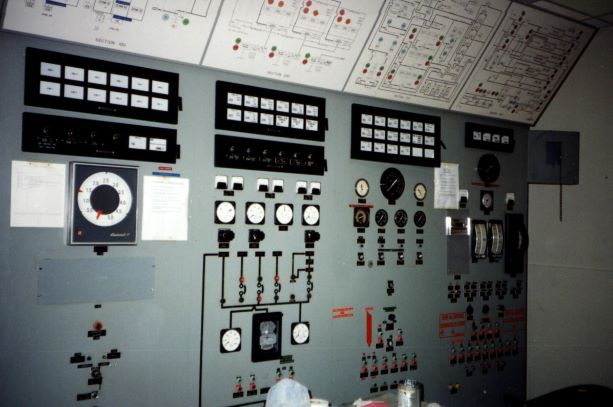

Tribute to General J. V. Allard – Designed and curated by the Department of National Defence (DND) this exhibit was created to honour General Allard who was Chief of the Defence Staff from 1966 to 1969. It was erected in the former Crypto room of the Diefenbunker and highlighted the benefits of having a modern defensive military.
Requiem – Opened in 1999 by the Japanese Ambassador and embassy personnel, this was the museum’s first exhibit. It was curated by volunteers Doug Beaton, Louise Fox. Robert Moreau, Connie Higginson-Murray and Mike Prochazka. In addition to wall panels and a contemplative centre resting bench, it consisted of 22 photographs of the damage done to humans and structures at Hiroshima and Nagasaki as a result of the atomic bombs. The powerful, thought provoking photographs were on loan to Dr. Barry Bruce, a member of the group ‘Physicians for Global Survival’ and one of the founders of the Museum. This exhibit was removed in 2019.
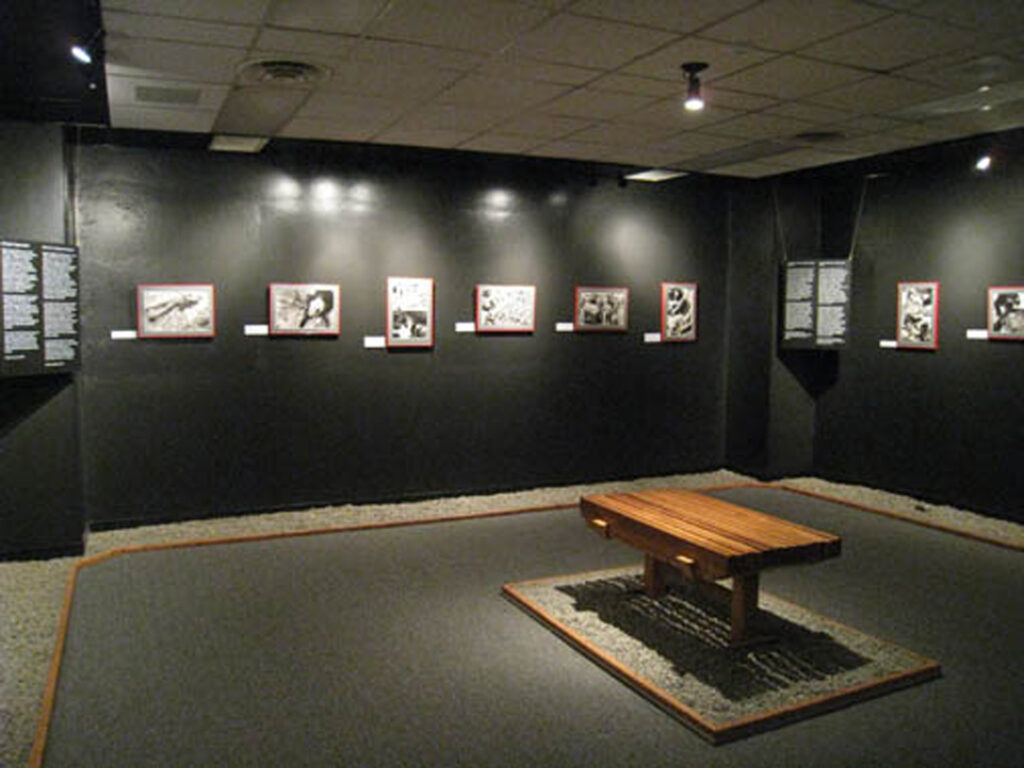
The Horrific Results of the Hiroshima and Nagasaki A-Bombings – A lesson for future generations.
(Since removed by current Diefenbunker Museum Administration as not suitable for children – replaced by a conference room)

Radiation: Birth to Bomb – Curated and designed by Doug Beaton in 2015, this interesting one room exhibit used text and rare period artefacts to highlight the procession of important breakthroughs in scientific knowledge that led from the first understanding of radiation in 1895 to its eventual use to create an atomic bomb. The second half of the exhibit contained artefacts that illustrated the social acceptance and usage of radioactive products in daily life. This exhibit was removed in 2018.


The Hiroshima Nagasaki Exhibit – This major world traveling exhibit was curated in 1995 by the Hiroshima Peace Culture Foundation. Consisting primarily of 68 large text panels and a few replica artefacts, it was mounted in 2002 on special interlocking panels fashioned by volunteers in the Bank of Canada vault and along its tunnel. A shard fragment from Hiroshima was donated to the museum after this exhibit left for the US in 2003.

The Atomic Photographers Guild – This travelling exhibit entitled “Visibility and Invisibility in the Nuclear Era” was curated by R. Del Tredici and consisted of a selection of photographs taken by members of the guild. The photographers of the guild document the history, impact and legacy of what was called the atomic age.
The Canadian Forces Artist program – This travelling 3 month exhibit was called “Group 6: The Canadian Forces Artists Program 2012-2013”. The many photographs and visual/audio displays portrayed the Canadian Armed Forces personnel at home and abroad.
Afghanistan, Unordinary Lives – Civilian life for Citizens of Afghanistan in the Aftermath of War – This 3 month exhibit sponsored by the Embassy of Slovenia highlighted the photographic works of Slovenian artist Manca Juvan who spent some months in the war torn country.
Three exhibits sponsored by the German Embassy (Nov 2014)
- Dictatorship and Democracy in the Age of Extremes: Spotlights on the History of Europe in the Twentieth Century
- German Canadian Graffiti Jam: The Bunker Reunion
- The Wall, Niederkirchner Strasse by Leslie Hossack
Ottawa Museum Network ‘Preserving Our Past, a Conservation Project’ – This travelling exhibit was the product of the Ottawa Museum Network (OMN) working with several local museums in order to provide conservation treatments for some of each museum’s most important artefacts. The artefact chosen by D. Beaton at the Diefenbunker was one of the binders of original construction photographs.
Original Condition Bedroom 400 level – So that visitors could appreciate the restoration efforts of the early founders and volunteers of the museum, one room was left ‘as found’ from the 1995 closing of CFS Carp. With burnt out lighting, damaged walls and soiled flooring it presented a stark reminder of what the Diefenbunker looked like after the Army left the station.
Continuing Exhibits
Construction of the Diefenbunker/the FENCO model – Originally housed in another room, this exhibit was moved to its present location once the 2009/10 Diefenbunker fire retrofit project was finished. It features some of the photographs previously curated by Connie Higginson-Murray of the building construction, copies of two 1961 articles published in the Toronto Telegram by George Brimmell announcing the EASE Project to the public and a portable radiation detector original to the Diefenbunker. It also houses the original large scale model made for the Foundation Engineering Company (FENCO) which was used by engineers and architects to better visualize this complex structure. The model and the radiation detector are on loan from the Canadian War Museum.

Air Raid Sirens and Practice Bomb Display – Organized and curated by the founders of the museum, an exhibit of three typical Canada-based air raid sirens and two practice ‘drop-bombs’ (one 1,000 pound conventional bomb and a Mark 43, 1-megaton hydrogen nuclear bomb) that are on loan from the Canadian War Museum, were placed in the Butler Hut soon after the museum opened. Later, a replica of the first ‘Lost Nuke’ atomic bomb was added to the exhibit.
The ‘Lost Nuke’ Exhibit – Curated by staff and volunteers such as Dr. John Clearwater, this exhibit details the mystery behind the world’s first atomic aircraft accident resulting in the loss of an atomic bomb and B-36 bomber. The Diefenbunker acquired an archaeological permit from the Province of British Columbia for Dr. Clearwater to visit the site in BC and to return some bomber artefacts for the museum’s collection and for exhibit.
Atomic Age Exhibition – Created by two Algonquin College Museum Technology students with funding by the museum, this exhibit displays atomic related artefacts from the Diefenbunker’s and the Canadian War Museum’s collections.
Community Fallout Shelter 400 level – In an empty office on the 400 level, Dave Peters and other volunteers have recreated a facsimile of what would be a community fallout shelter. The re-creation is based on vintage publications in the museum’s archive describing the make-up of a typical fallout shelter for a small group.
Family Fallout shelter – In an empty bedroom on the 300 level, volunteers recreated what would be a possible layout of a family fallout shelter. At the time, the museum had a school program that involved local high schoolers and their teachers who helped at the site as part of their curriculum. Using their help this exhibit was augmented by text panels that explained the effects of nuclear war. Eventually this room was relocated to the 400 level where Lorne Beaton fabricated a false cinderblock wall and benches to house the upgraded exhibit, complete with original pamphlets and booklets for the public to read.

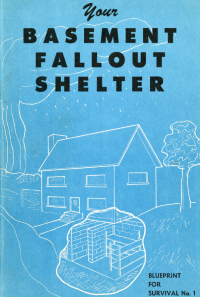
The NESS Civil Defence Service – Curated by Dave Peters and Dr. Barry Bruce it was built by museum volunteers and Algonquin College Museum Technology students. This exhibit on the 400 level highlights the background of the National Emergency Strategic Stockpile (NESS) that was created to provide provinces and territories with extra medical supplies in civil defence emergencies.

The United Nations Peacekeeping Story – Curated by Dave Peters and colleagues, it was mounted by museum volunteers. This 400 level exhibit focuses on the peacekeeping role of the United Nations through the experiences of several Canadian peacekeepers.

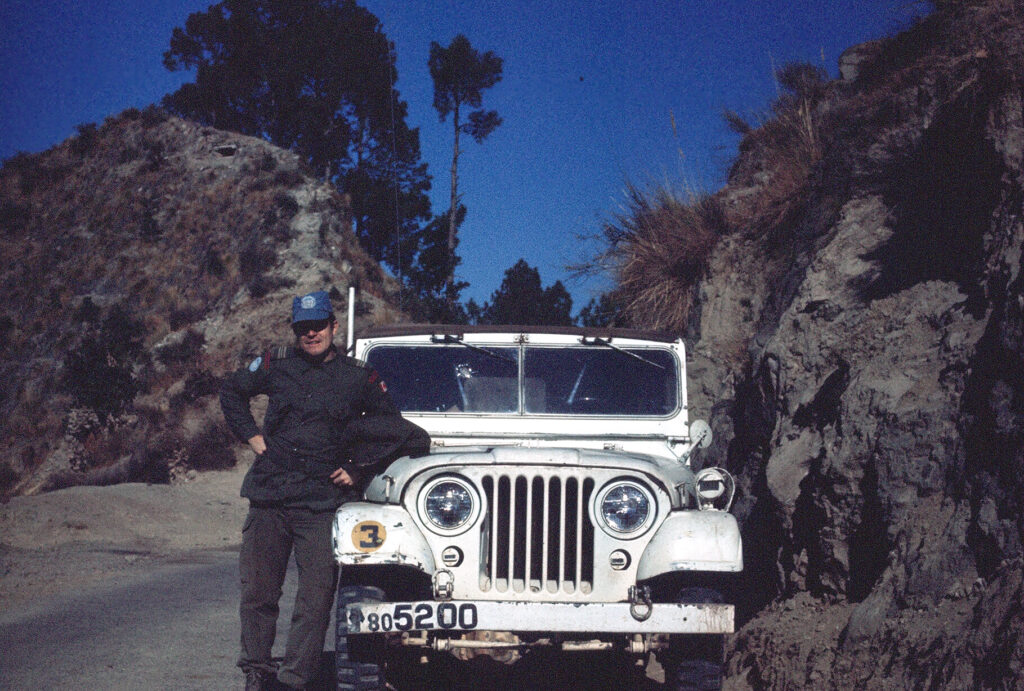
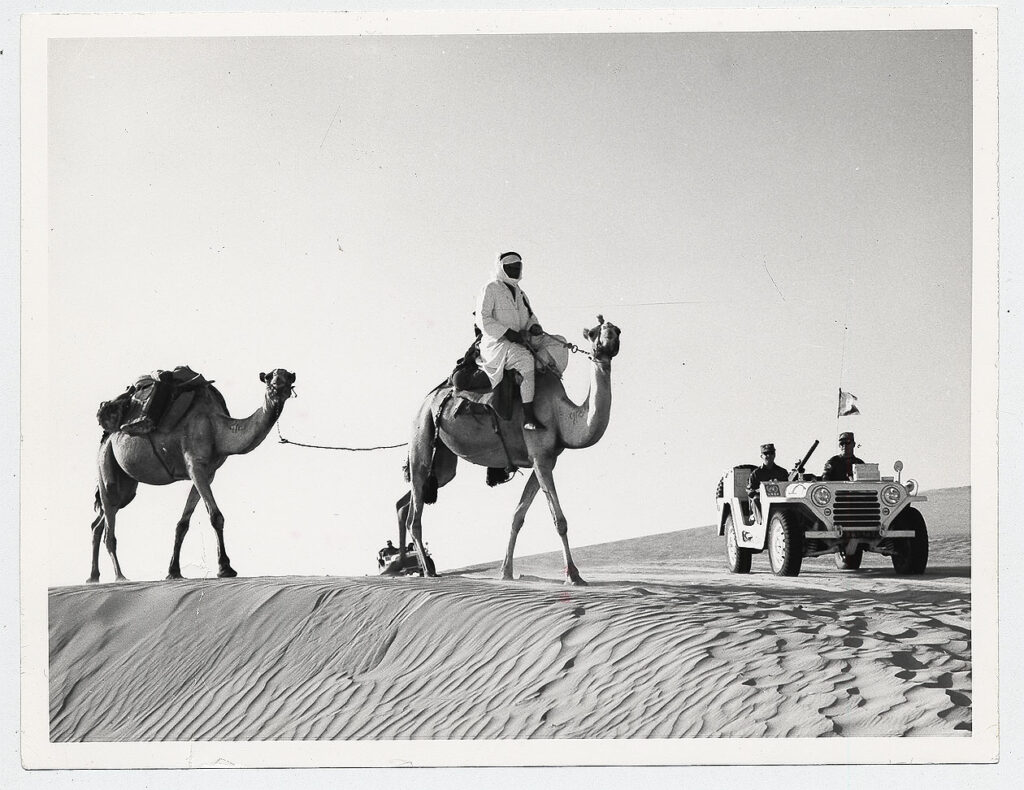

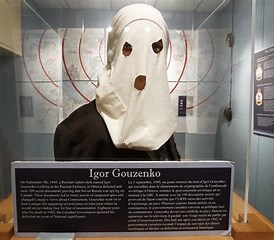
Cold War Ottawa – Prepared by students from Algonquin College’s Museum Technology program in cooperation with guidance provided by the Museum’s Presentation Committee, this 400 level exhibit highlights several Cold War events specific to Ottawa and the Federal government such as the defection of Igor Gouzenko and the Gerda Munsinger affair. It also has a large map depicting the damage the would result from detonating a one megaton bomb over Ottawa.
The Cuban Missile Crisis and Canada’s Maritime Role – Curated and funded by Russ Hicks and built by Doug Beaton, this exhibit is a copy of an exhibit first prepared for CFB Greenwood. It tells the story of the role of the US and Canadian maritime forces in the defence of Canada and specifically during the Cuban Missile Crisis.
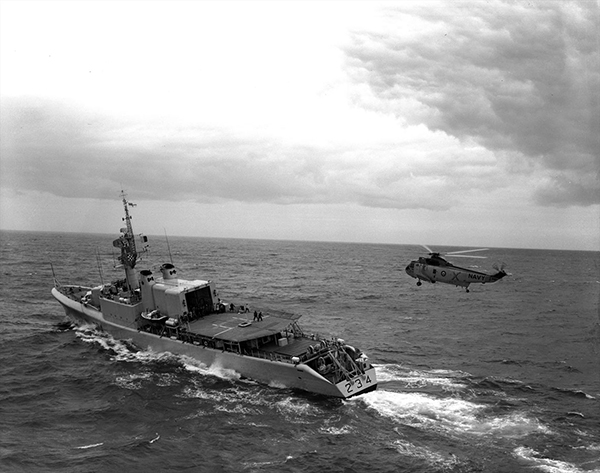
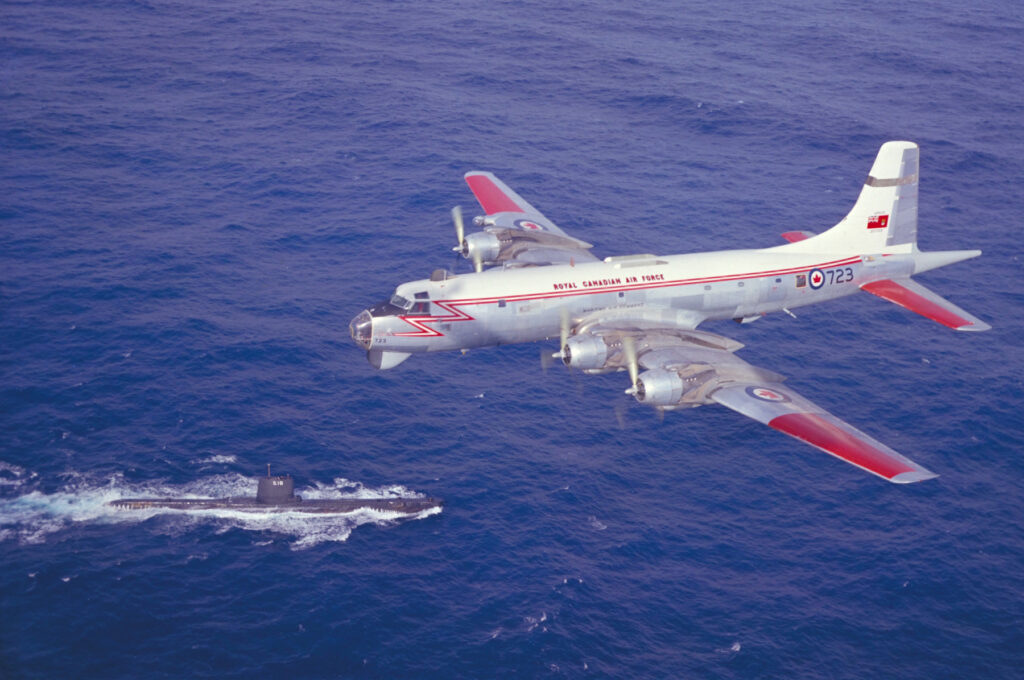
Canada in the Cold War – This multi-room walk through exhibit was curated and designed by Alexandra Badzak and museum staff in 2010. Housed in the former STRAD area, each room contains artefacts and panels highlighting consecutive decades of the Cold War.
Cold War Berlin – Curated and mounted by students from the Algonquin College Museum Technology program, this exhibit shows the story of Cold War Berlin through the use of artefacts (some from the Diefenbunker’s collection) and other visual displays.
Symposiums and Special Events Sponsored
Interdisciplinary Symposium “Cold Culture” Nov 2008
“Cold Culture” was an interdisciplinary symposium held at the Diefenbunker in Carp Nov. 7-9, 2008. This event brought together Francis Gary Powers Jr., Founder of the US Cold War Museum, Dr. Christian Ostermann, Director of the Cold War Historical International Project and Yvonne Morris, the last Commander of a active Titan 2 Missile Base (Green Valley, AZ) and the then Executive Director of the Titan 2 Missile Site Museum
This event was organized to bring together a broad range of professional scholars, artists, filmmaker, teachers, museum professionals and journalists involved in the exploration of themes in Cold War history, and who shape how the conflict is understood today. Held at one of Canada’s most distinctive Cold War sites, this conference was a forum for diverse voices to reflect on and share their approach to the Cold War in different media.
In this image Dr. Barry Bruce (one of the primary founders of the Museum) is introducing the Tribute Panels about the various cold war conflicts/ideologies that had shaped our world.
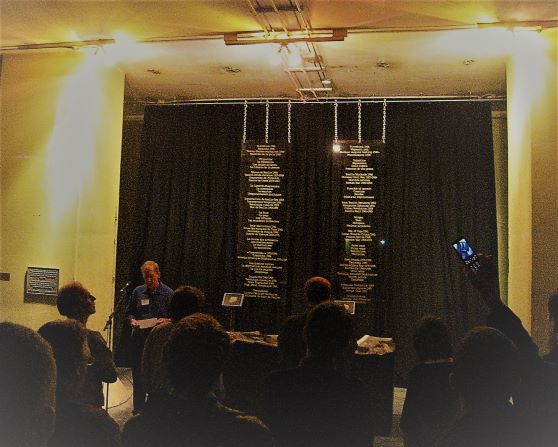

This (Bank of Canada Vault) area was intended to be devoted in perpetuity as a memorial to the victims of the Cold War. There is an aluminum plaque on one of the columns to this effect. (The aluminum is from a decommissioned armoured personnel carrier and it and the money for the plaque was donated by DEW Engineering of Ottawa. The plaque was fabricated by the Alloy Foundry of Merrickville, ON.) The tall plexiglass panels seen in the background were used annually for several and years to commemorate the human losses as a result of cold war conflicts and communist revolutions etc. What has happened to these plexiglas panels after they were taken down by the bunker staff is not known. The photo shows the dedication of the debris field ‘sculpture’ that Doug Beaton made for Alex Badzac (the then Executive Director of the Museum and principal organizer of the Symposium) which contained and highlighted a shard from Hiroshima, and a fragment of the Berlin wall that we own in our collection). The “Symposium Diefenbunker 2008” was a real feather in the Diefenbunker Museum’s cap as it attracted many folks from the US and some from Europe. It was conceived as being an annual event but of course that did not happen.
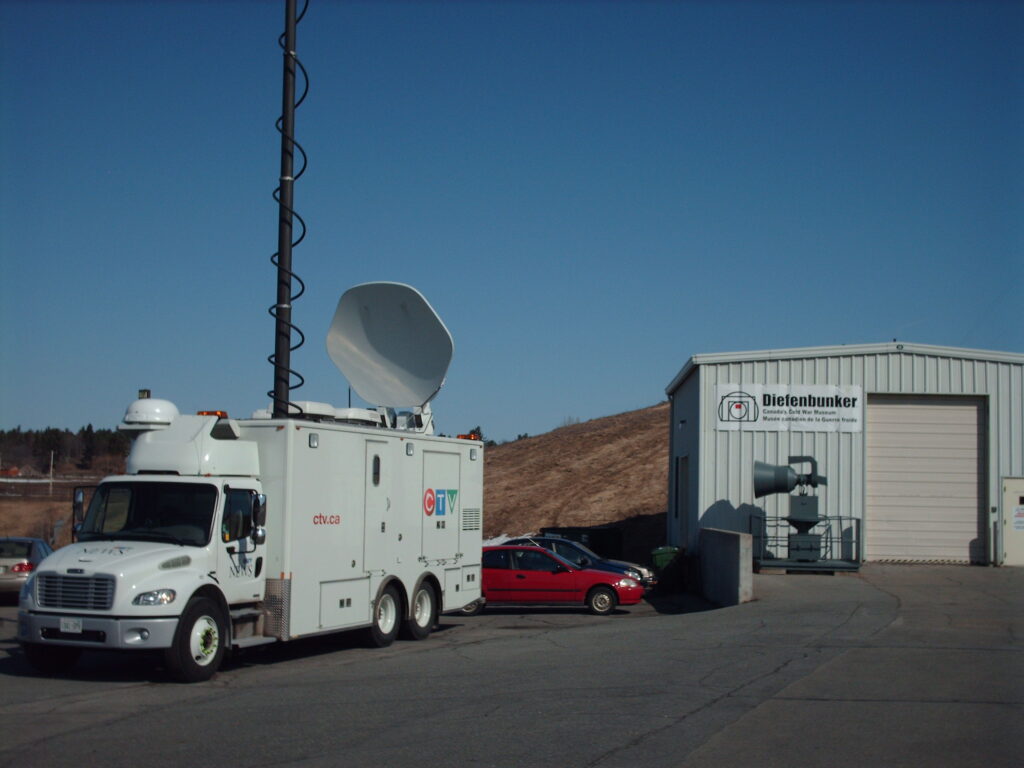
CTV Live Broadcast from the “Bunker” 2008
It was April 2008, and was a result of the efforts of Louise Fox that we were able to have the CTV Morning crew at the site for an entire day. Tour attendance rose significantly in the days following.! Jeff Hutchinson of CTV toured the bunker and interviewed many of the volunteers and staff of that time.
The March 23rd, 2009 Genie Awards
Ottawa movie lovers got free screenings ahead of the Genie gala. The National Capital Commission (NCC) announced a week of free film screenings in the lead-up to the Genie Awards, the annual awards for the best in Canadian film.

Among the highlights of the screenings and other events that took take place between March 28 and April 4 Was a screening of multiple nominee Passchendaele, a film about the First World War, at the Diefenbunker, a Cold War-era bunker near Ottawa.
A quote by the NCC’s Guy Laflamme at the time says …”the commission wants give the public a chance to discover Canadian film…we have come up with a very sexy program,” he said. “Imagine being able to watch Passchendaele in the Diefenbunker, that’s just going to be so real …”
Artist-in-Residence and Other Temporary Exhibits
Guy LaFontaine “Lights in a Blast Tunnel” (1998)
A photographic essay consisting of large black and white ‘industrial’ style photographs taken of the then newly vacated Diefenbunker in 1997.
Axe-Neo7 “Singular Fission” (2000)
Organized by Connie Higginson-Murray, this millennium project involved 13 artists from around the world who were tasked with creating individual works based on each artist’s impressions of the site.
The exhibition singular FISSION, curated by Jacques Doyon and Richard Gagnier in partnership with the Gatineau, Quebec gallery Axe NÉO-7, opened in July 2000. The Diefenbunker, CCWM seized this opportunity to entice art patrons, who might never be motivated to visit a Cold War nuclear bunker, to visit in order to see this novel exhibit, while Axe Neo 7 saw the exhibition as an opportunity to expose visitors, who might not necessarily visit a contemporary art gallery, to the exciting world of contemporary, avant-garde art and a truly Canadian interpretation of the Cold War through art.
The the key themes of the exhibition were sheltering and vulnerability; personal memory; modern ruins; and communication. Some installations were created primarily for singular FISSION, while others, for example the pieces by artist Wanda Koop borrowed from the National Gallery of Canada, were loaned from national and international galleries.
Participating artists were:
• Kim Adams, Grand Valley, Ontario• Miguel Berlanga and Renée Pierre Alain, A&B associés, Ottawa, Ontario, and New York City, New York• Guy Blackburn, Chicoutimi, Quebec• Josée Dubeau, Gatineau, Quebec• Denis Farley, Montreal, Quebec• Adrian Göllner, Ottawa, Ontario• Wanda Koop, Winnipeg, Manitoba• George Legrady, Stuttgart, Germany, and California• Liz Magor, Vancouver, British Columbia• Sophie Ristelhueber, Paris, France• Jana Sterbak, Montreal, Quebec, and Barcelona, Spain• Annie Thibault, Gatineau, Quebec; and • Hiromi Tsuchida, Tokyo, Japan
singular FISSION was funded by $86,500 from “The Canada Council for the Arts, Millennium Arts Fund” grant, $10,000 from the Canada Council publication fund, $10,000 from Axe NÉO-7, as well as other generous corporate contributions. The exhibitionreceived marked attention from art magazines, and was reviewed by national and international media.
Jesse Stewart (Aug/Oct. 2015)
Local artist Jesse Stewart created several works in various mediums such as sound, music and imagery to invoke special experiences throughout the Diefenbunker, CCWM on several occasions.
Leslie Hossack “Fallout” (Sept 2012)
International photographer Leslie Hossack created a series of images of various areas of the Diefenbunker, CCWM for her exhibit.
Annette Hegel “Now You See Me…” (Sept – Dec 2018) Annette produced a series of imagery utilizing the secrecy and camouflage found at the Diefenbunker, CCWM and other Cold War sites.
Anna Frlan “The Age of Atomic Anxiety” (Sept 2016 – Jan 2017) A series of steel sculptures depicting the artist’s impressions of the atomic age and the threat of atomic war.
Gail Bourgeois “To Warn Other Canadians” (Apr-Aug 2014) Gail spent considerable time at the site and produced several works in various media depicting her impressions of the building, its purpose and the feelings of fear and suspicion warnings of the age.
Embassy of Hungary “For Freedom and Independence” and “Hungarian Exodus”. Two travelling exhibits portraying the personages of the early beginnings of the Hungarian 1956 revolution and the exodus of Hungarians to Canada.
Pixie Cram “Emergency Broadcast” (2017) Pixie created amazing stop action videos using actual artefacts and props from the Diefenbunker collections and recreated rooms.
Marcia Lea “The Diefenbunker: Portrait of a Fortress” (2006-2008) A series of watercolours capturing iconic imagery inside the Diefenbunker, CCWM.
Valerie Noftle “From Hand to Hand” (Jan – Aug 2017) A series of photographs of the hands of military personnel along with the stories of the individuals.
Carol Wainio “Disasters for Little Children” (Sept 2019 – Jan 2020) Through several paintings, the artist explores current and past fears through the use of fairy tales and makes use of the Diefenbunker, CCWM as a way to express those fears.
Functional Re-Creations
Governor-General’s Rooms 400 level – Although the shower area in this room was gutted sometime in the 1990s, the bedroom, office and exterior office of the GG’s area was recreated using period furniture from the Shilo REGHQ. The original Teleprinter from the secretary’s front office was located in the collections of the Canadian War Museum and efforts to have it returned on loan were almost complete when it was decided to mount an exhibit (Cold War Berlin) in those rooms instead of a re-creation.
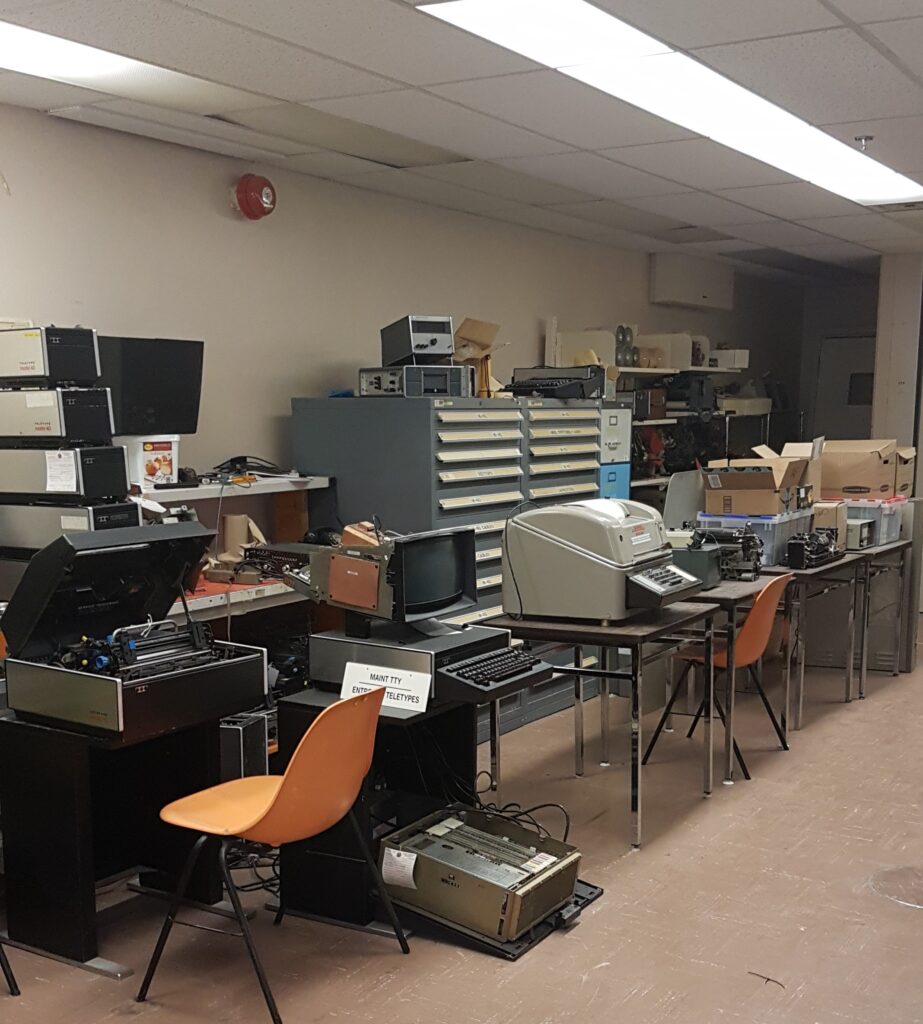
Teleprinter Repair Room 400 level – The original teleprinter repair/maintenance office on the 400 level was recreated by volunteers to circa 1965-1982 using a donation of period teleprinters, period furniture, equipment, tools and printed manuals etc. Interviews with several personnel who worked in that room allowed the volunteers to accurately refurnish the room as it would have appeared in the early period of the Diefenbunker.
Medical Centre 400 level – There are actually six original artefacts in these rooms, however, the look of the medical centre was restored using equipment and furniture donations from DND (Camp Petawawa), Dr. Barry Bruce, the REGHQ at Shilo, the Ottawa Heart Institute, St. Lawrence College and local donations. A recent donation from the NESS centre in Ottawa will eventually be used to augment the re-creation which is based on photographs and information from past CFS Carp personnel.
Overflow Hospital Room 400 level – This room is one of two unique bedrooms in the building. Capable of being locked from the outside and containing an interior wall, three bunkbeds from the REGHQ Camp Borden and two fold down cots from REGHQ Debert have been used to recreate an original look.

The Decontamination Chamber – Persons entering the Bunker after a nuclear weapon had detonated in the Ottawa area would have had to be checked for radioactive fallout before being allowed in. If testing positive for radioactivity they would have had to go through the decontamination procedure. For many years a mannequin dressed in a NBC protective suit and carrying a gieger-counter used to be located in this area (representing the radiation monitor) but it must have been too scary because it was removed by the staff a couple of years ago.
Message Control Centre 400 level – Using furniture and equipment from the REGHQ Shilo and donated period furniture volunteers have restored this office to much like it must have appeared during an early period of the Diefenbunker.
Telephone Exchange Area 400 level – Although not open to the public, this room has been restored to an early period using a vintage 701 switch, similar to the original, that volunteers purchased and brought back from New Jersey. When the military left in 1994, this room had been virtually destroyed and it has taken volunteers several years of ongoing work to restore it and to also provide for a modern telephone system for the museum.
Darkroom and Dental Office 400 level – Although this room is marked as having been used as a darkroom (to develop X-rays) in the early days of the Diefenbunker, it later became a dental office. Dave Peters acquired the period artefacts from an army dentist and the room was restored to the later period with vintage props.
Radio Room 400 level – This room had been almost stripped of all original equipment after 1994, however, there remained much of the shock-absorbing floor mounts on one side of the room as well as much of the ceiling mounted fixtures. The volunteers of the amateur radio group acquired several period correct transmitters and receivers and have restored the look of this room using other donated equipment and have gone much further to create a working amateur radio station.
Amateur Radio Station VE3 GOC 400 level – The volunteer amateur radio group at the museum, headed by Brian Jeffrey and Nick Shepherd have worked for years to restore this critical function at the museum. Initially the VE3 GOC (Government of Canada) amateur radio station was located in downtown Ottawa on Slater St. In the 1980s it was moved to this room at the Diefenbunker. The radio group have recreated not only the look of the facility using actual photographs taken years before by Dave Peters, but they have installed working period radio equipment and now operate as VE3 CWM. The have also established a link up through the ceiling (in the radio room) to the original antennae complex and have plans to add one more antennae that will enhance the visual impact of the cultural landscape on the hill and increase their ability to receive and send signals.
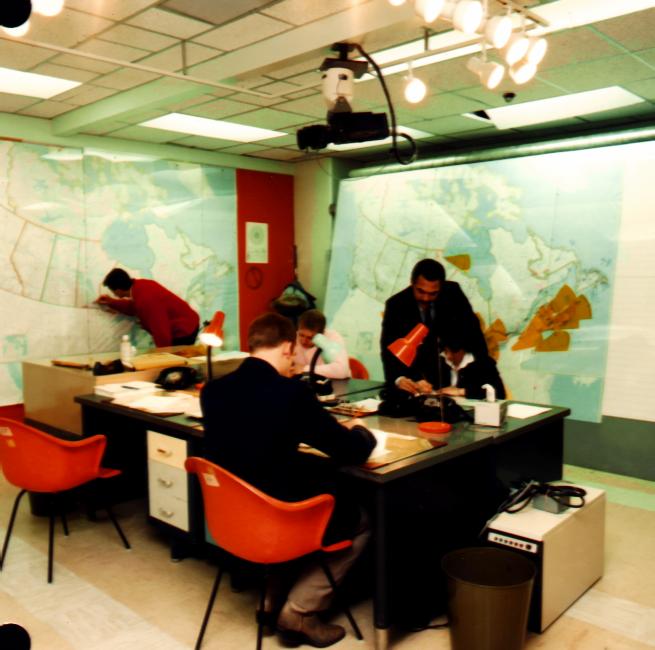
Emergency Government Situation Centre 300 level – This was one of the first rooms to be restored by the volunteers soon after the building was purchased. Dave Peters had not only been personally responsible for the establishment of this function in the early 1980s, but he also had many photographs of it as it was, as well as many contacts of personnel who had worked in that area. He acquired the original nuclear detonation map from the Canadian War Museum and guided the reconstruction of its lighted mounting system, recreated the alert status board and other large maps used to plot fallout. In 2003, Dave arranged for the acquisition through Crown Assets of more original equipment and furniture in that room such as the map board, televisions and camera systems, filing cabinets, TV switching equipment and Canada wide bunker readiness panel from the Canadian Civil Defence College at the former CFB Arnprior. Along with a donation of an original desk and original telephone, this room has become a very accurate period restoration circa 1984.
Combined Secretariat – Thanks to Dave Peters, Brian Jeffrey and other volunteers this room has been restored to a later period using many pieces of original furniture acquired through Crown assets from the former Canadian Civil Defence College and the former Emergency Preparedness Canada.

Female Sleeping Quarters 300 level – Through the work of Dave Peters and Bob Borden, the museum acquired several large quantities of furniture and equipment from the REGHQs at Shilo and Camp Borden. Using these, this room was outfitted to resemble a typical female quarters bedroom on the 300 level.
Encrypted Telephone rooms 300 level – Using furniture from the REGHQ at Shilo, one of the three encrypted telephone rooms on the 300 level was interpreted as it may have been in the early years of the Diefenbunker.
CBC Studio 300 level – Thanks to museum founders Dr.Barry Bruce and Connie Higginson-Murray, the original CBC studio equipment was acquired on loan from the Canadian War Museum which had removed it intact in 1995. Museum volunteer Jim Morrison, who was a CBC technician tasked with checking the worthiness of the equipment on a twice yearly basis was instrumental in reinstalling the equipment, window and tool cabinets as they were throughout the life of CFS Carp and ensuring that the equipment still functions as it once did.
EPIS Room 300 level – Using period furniture donated by the former Emergency Preparedness Canada (EPC) volunteers re-created the Emergency Public Information Service office opposite the CBC studio.
CANEX 200 level – Thanks to photographs donated by members of the CFS Carp Alumni Group and a few photos in the museum’s archive, it was possible for a museum staff member and Doug Beaton to somewhat restore the look of the Canex to what it resembled circa 1977 using reproduction facsimile products.
Escape Hatch – In order for the public to see and understand the complexity of the two escape hatches on the 400 level, volunteers made a working scale model of the system, based on actual blueprints held in the museum archive. In addition, the interior of the escape room and pit was illuminated and a mirror was placed in one so as to allow visitors to see the bottom of the steel tube, filled with washed river stone that leads to the surface.
Federal Warning Centre and Anti-room 300 level – Using actual blueprints from the museum’s archive, in 2010 a group of volunteers reconstructed the Federal Warning Centre as it was in the mid-1980s. Dave Peters supplied reproduction place names for the personnel serving in this area, worked with Hugh Pett to install a working projector to simulate the actual military and civilian images on the main screen and Executive Director Alexandra Badzak to acquire similar lecture-style chairs for the room. A continuous loop projection recreated the imagery on the main screen to create a real time atmosphere for visitors passing through.
Environmental Control Computer System ‘Myrtle’ 400 level – One of the very few original artefacts left on-site after the building was cleared of equipment by the DND in 1994/5, the Hewlett-Packard mainframe known as ‘Myrtle’ was restored by volunteers to working condition, along with its ancillary original monitors. The volunteers included Ed Crack who was responsible for Myrtle in the later period. Ed brought back dozens of original manuals for the system (now in the museum archive). Period furniture was used to create the section as it was.
Meteorological Office 300 level – Using furniture from various sites and some original artefacts, volunteers started to restore this valuable function room. The wind speed and direction plus weather systems around the world would have been vital information to other personnel in the Diefenbunker. Today it remains partially incomplete and is not open to the public.
Machine Room Generator 100 level – When the founders of the museum first entered the site in 1997/8 some of the machinery in the machine room area still functioned, primarily anything related to safety. Volunteers repaired some of the ventilation fans, water tank holding system and well system. Thanks to Bob Borden and others, a 6-ton Mirrlees diesel engine and generator, identical to the original models used at CFS Carp was acquired in 2005 from the REGHQ at Camp Borden. It was removed from the Borden site by Lorne Montgomery’s heavy equipment team and brought to the site, where it remained many months in the Butler Hut until it could be dismantled and reassembled down in the machine room. After building a custom cradle for the engine block and refurbishing the 5-ton chain hoist in the machine room, the team was able to reassemble the engine in the machine room. Unfortunately, after the fire retrofit in 2009/10, the public was not allowed to regularly enter the machine room.
Septic Field – As the popularity of the museum grew, so did the demand for water for sewage. Volunteers and staff worked with the City to find a solution and eventually Bob Borden arranged for a local heavy equipment training team to build a new septic field at cost. Unfortunately, this involved the replacement of the one operating well pump (400 GPM) at considerable cost and an upgrade to the interior pumps and water holding tank.
Ottawa Semi-Automatic Exchange OSAX 200 level – Before the museum opened, the OSAX area was not only empty, but dangerous due to the lack of floor tiles. Thanks to volunteers, the area was refurbished and eventually recreated using vintage IBM and Bull computers acquired by Gord Heath from Carleton University. These were transported to the site by a team of volunteers and reassembled in-situ to recreate the look of the Burroughs computers and recording devices that were there in the 1980s.
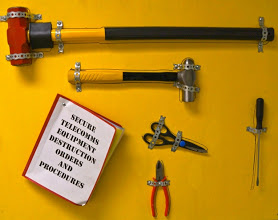
Destructive Tool Board 300 level – Located just across from the OSAX room and also in the Encryption room on the 400 level were two wall-mounted boards to hold some tools that could be used to destroy equipment should the need arise. The 400 level board is original but volunteers have re-created the 300 level board.
War Cabinet 300 level – This room was one of the first to be recreated by volunteers as there was an early need for a board room in the museum. Desks were purchased and moved in from Crown Assets and an electric projection screen at one end was found to simulate the original. Wall boards were added to further recreate the original look of the area yet allow for general use by staff and visitors.
Ministerial Offices 300 level – Many of the Minister’s and civil servant staff rooms were recreated on the 300 level using furniture from the former REGHQ Shilo, the former Canadian Civil Defence College at Arnprior, Emergency Preparedness Canada, and a variety of props purchased by volunteers to augment the look and authenticity of the offices.
Storeman’s Office 100 level – As the early guided tours took the visitors through this small office on the 100 level, it was recreated using furniture from the former REGHQ Shilo and period props.
Radiation Detector Calibration Area 100 level – One of the most important rooms in the building is the radiation detector calibration room on the 100 level. A volunteer (a former employee in this room) helped to recreate the look and function of the room by cleaning up the area of the radioactive cesium container and adding some of the original detection apparatus that was on loan from the Canadian War Museum such as the various radiation detectors and portable ‘rad sniffer’ units.
Prime Minister’s Bedroom 300 level – The area consists of 3 rooms: the PM’s bedroom; PM’s office; and his/her secretarial office. A former CFS Carp employee and long-time volunteer Peter Remillard donated the original chest of drawers and small table and Doug Beaton was able to track down the original bed. An original Diefenbunker mirror from elsewhere in the building was used to complete the restoration of the PM’s bedroom. Vintage furniture was donated to restore the period look of the two exterior offices.
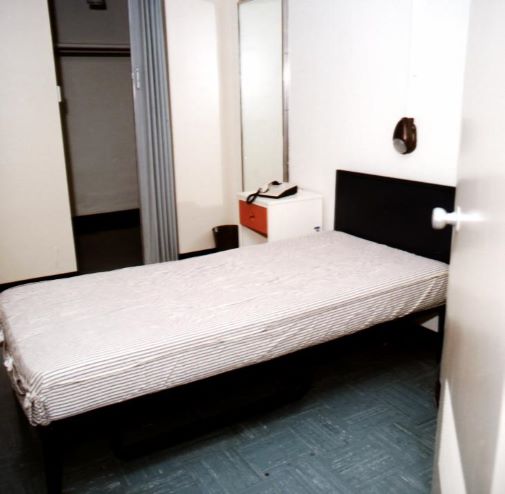
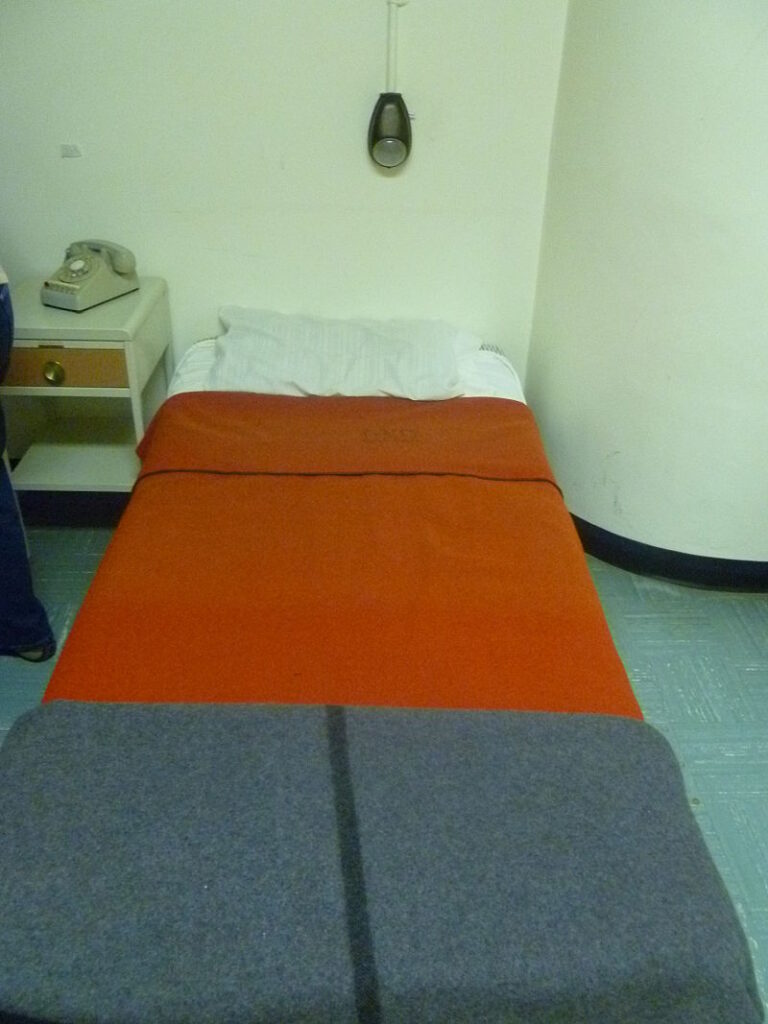
Bedroom Area 100 level – When the museum was first opened in 1998, a set of 3 original bunk beds remained on the 100 level. Doug Beaton found a donor for 6 mattresses and with an original mirror from CFS Carp and chest of drawers from the REGHQ Shilo, the look of an original nine person bedroom was completed.
VIP Lounge 200 level – Volunteers restored the look of this room which had been used as a recreation and exercise room through the addition of exercise and television equipment. Unfortunately, much of this equipment was damaged over the years and along with the original carpet, had to be removed.
VIP Bedroom for the RCMP Commissioner 200 level – As the VIP lounge and VIP bedrooms on the 200 level were on the original tours of the building, one VIP room was outfitted with possible furniture and props to simulate a probable look.
Cafeteria and Kitchen 200 level – Shortly after the museum opened, volunteers located some of the original cafeteria tables and later-era metal/plastic chairs. Props and artefacts were located to restore the look of the recreational areas of the cafeteria (pool table/shuffleboard/dart boards, hanging plants, and pool table wall scoring boards). Efforts to get the original walk-in fridges working were unsuccessful as were efforts to locate some of the original kitchen equipment. Early guided tours took the visitors through the kitchen areas and the food storage rooms directly underneath on level 100.
Federal Communications Centre FCC 400 level – These two rooms have not been restored and are not on the visitors route. However, they were first modified by volunteers into an exhibit construction workshop and a meeting room. Over the years, one has been changed over to the staff cafeteria and the other has become the museum’s main archive. In 2003, Dave Peters was able to secure through Crown assets, the holdings of the Canadian Civil Defence College at the former CFB Arnprior. Thanks to the donation of a 53 foot truck from John Laurysen Kitchens (Carp road), volunteers were able to remove tens of thousands of civil defence books, documents, brochures and other ephemera that would become the main body of the Diefenbunker’s archive. Around the same time, the same company volunteered their truck drivers to bring hundreds of pieces of furniture from the REGHQ Shilo facility (previously selected by Dave Peters and Bob Borden) to the Diefenbunker, CCWM just for the cost of fuel.
Emergency Preparedness Canada Office 300 level – Using some original Diefenbunker furniture and other pieces donated from EPC it was possible for volunteers to restore the look of the EPC office.
Food Storage and Refrigerated Storage Area 100 level – Over the years, staff and volunteers have been able to add some artifacts and props to this area to replicate what may have been in these areas.
